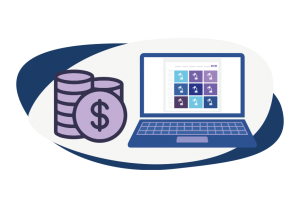
Your offer in Google Shopping – Costs and conditions in a nutshell
- 23 March 2021
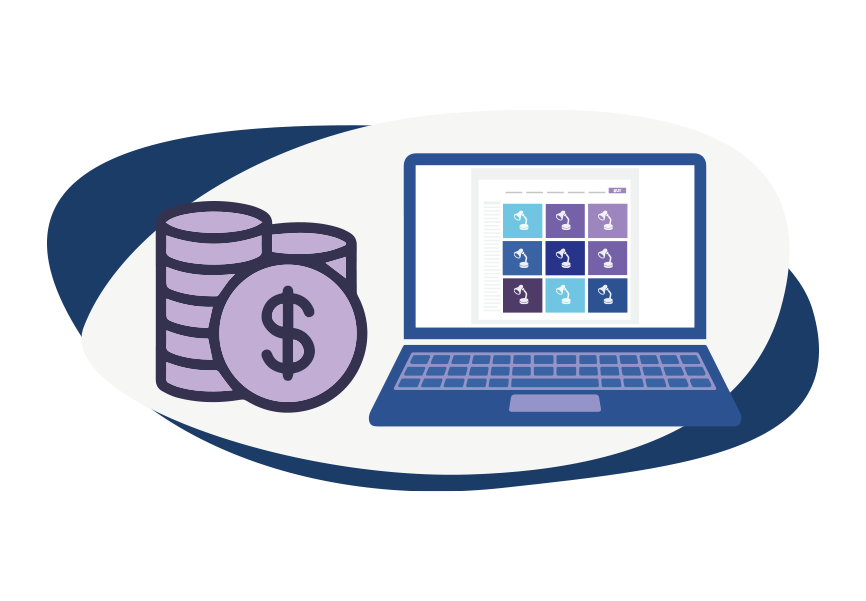
If you’ve ever looked for a specific product in Google, you certainly saw the Google Shopping ads presented in the SERP (Search Engine Result Page). Google Shopping is, in essence, a comparison shopping engine. Its main purpose is to help customers using Google find the products they want and purchase them without browsing tens of different online stores. That said, if you are an e-commerce entrepreneur – it’s a place to be!
In this article, we want to take a closer look at this service offered by the giant from Mountain View, as we believe that every decent online merchant should be present here with their offer.
What does Google Shopping look like?
The first thing you need to know is that Google Shopping works in two different ways. The first one becomes apparent when your customer types in a query in the search box. Suppose they’re looking for a gaming laptop, and this is what you’re selling. They have no specified requirements or brands in mind. Your potential customer decides to type in “gaming laptop” into the search box. Here’s what they see first:
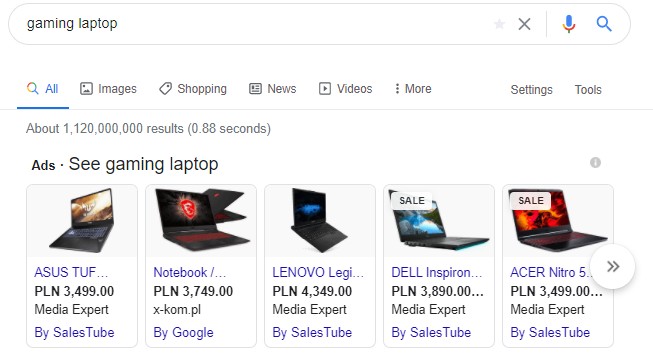
The Google Shopping service displays ads of the products and offers from online stores that match the phrase searched by a given user. These are Google Shopping Ads, formerly known as Product Listing Ads or simply PLAs. These ads are being displayed directly in the SERP. But let’s go further. There’s also the “Shopping” tab in the Google search tools. Your future customer goes there and discovers many more functions and features:
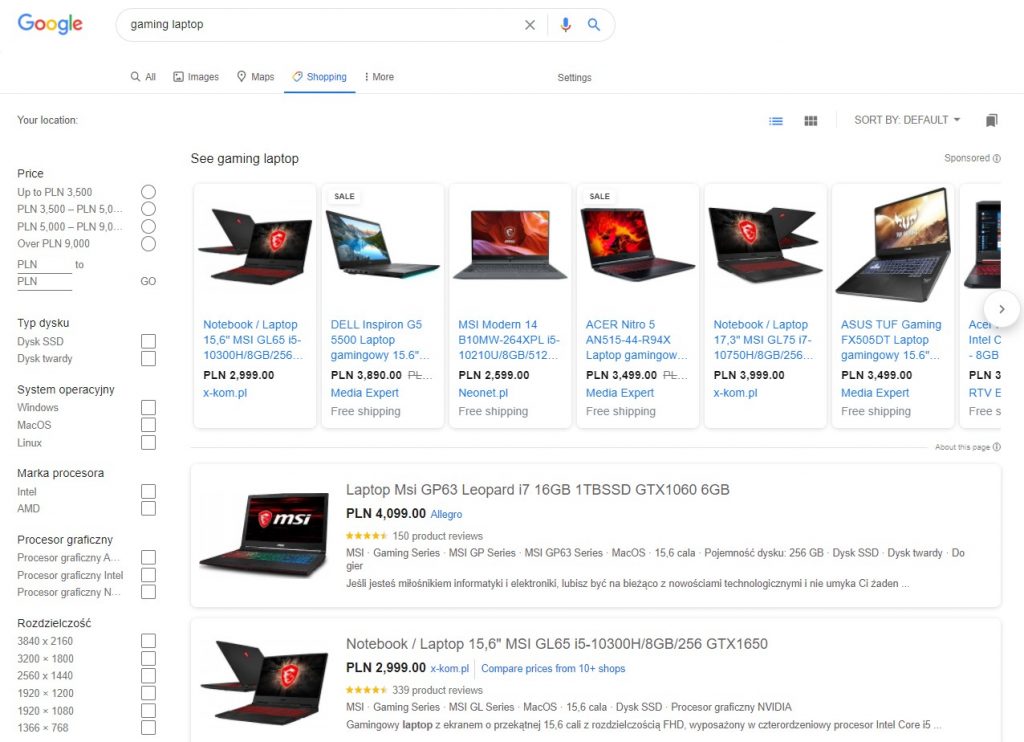
Now, they can see even more products that match the query. Google also offers a wide selection of additional search parameters:
- Price
- Brand
- Rating
- Shipping
- And several other product-related options (in our case, operating system, the hard drive size and type, etc.)
This way, your customers can select the best offer without the need to leave Google. It’s very convenient, right? Once they find the best gaming laptop, they can go directly to your web store’s site and purchase it.
Why should you present your offer in Google Shopping?
In a sentence? Because it works! According to the “Rise of Google Shopping” report, conducted by AdThena.com in 2018 in the US, advertising spend on Google Shopping Ads made up over 76% of retailers’ total search budgets and won over 85% of clicks[1], making this channel far more effective than standard text ads:
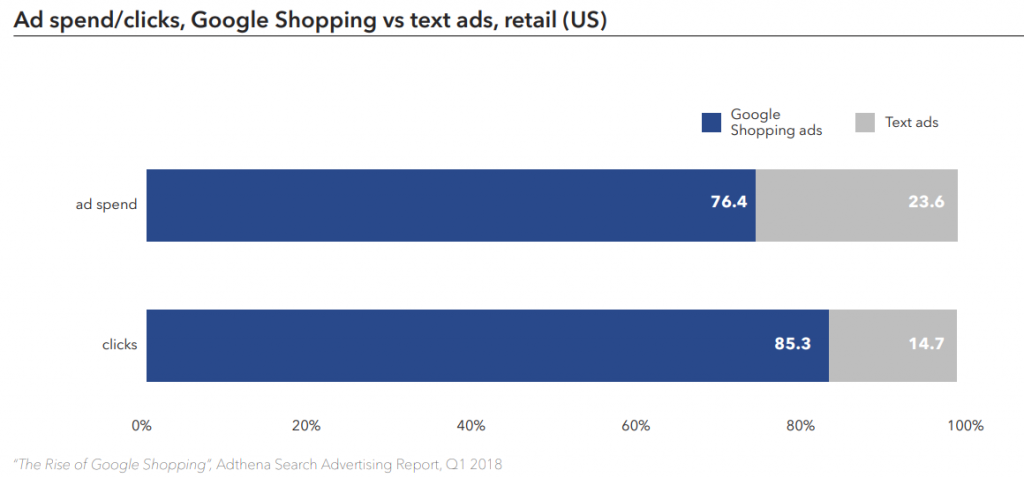
For e-commerce companies, Google Shopping Ads constitute the most straightforward way to reach the top of the SERP. Moreover, the majority of people are visual processors; therefore, shopping ads that come with a small image of the product usually win with the standard text ads. And last but not least, people more and more willingly use price comparison websites. Google Shopping is one of the leading ones.
The costs of presenting the offer in Google Shopping
The main cost is settled in the CPC (Cost Per Click) model, which means that you pay every time someone clicks your shopping ad. According to WordStream’s Google Shopping Ads Benchmarks (updated in May 2020), the average CPC rate is at 0.66 USD (data from sixteen different product categories). Interestingly, the most expensive category is office & business needs (1.09 USD), and the cheapest one is arts & music (0.34 USD).
Bear in mind that we are talking about average rates. The performance of your ads and costs of advertising are in your marketing department’s hands. Also, you should know about something called maximum CPE (Cost Per Engagement) bidding: You can set the highest amount of money that you’re willing to pay for a single engagement. You’re then charged when someone clicks a product in your showcase ad[2].
And while we are at the showcase ads, there are two basic forms of ads you can use to present products in your online store:
- Product Shopping ads: These are created based on the product data that you submit in the Google Merchant Center. Essentially, these are the very same ads we showed you in the first part of this article.
- Showcase Shopping ads: You can make these by grouping related products together. Here’s how these ads can look:

How can you start using Google Shopping?
If you want to present your products in Google Shopping, there are several steps you have to follow.
STEP 1: GOOGLE MERCHANT CENTER
First of all, you need a Google Merchant Center account. When you have it, you have to confirm that you own the store’s domain. You can do it via your Google Analytics/Tag Manager account.
We encourage you to read our recent blog post about GMC: What is Google Merchant Center and why is it worth using?
STEP 2: PRODUCT FEED
After you’ve created an account, you’ll need to organize info about your products to use in a feed or with the Content API. You can read more about building a product feed here and here. If you use one of the major e-commerce platforms like Shopify, WooCommerce, Magento, etc., you can download a dedicated app that will speed up your product feed set up. This part is crucial. If your product feed is not constructed properly, Google will most likely disapprove them, and you won’t be able to advertise in the Google Shopping tab.
STEP 3: TAXES AND SHIPPING
Next, you have to set up all the tax (here, you have to primarily concentrate on providing accurate information about taxes you collect so that users know how much exactly they will have to pay for your products) and shipping-related (minimum order value, delivery time, delivery zones, etc.) questions.
When all that is done, you can start working on your first Google Shopping campaign! If you are interested in the entire process, read this thorough Google guide on setting up the Google Merchant Center account.
Price monitoring with Dealavo
Google Shopping is a marvelous place to advertise your offer. One of the keys to success in this channel is the efficient pricing strategy. At Dealavo, we offer a Dynamic Pricing Platform for online stores. With our dynamic pricing, you can specify the rules according to which your store’s prices are to be set. For example, you can choose the “TOP 3 on the particular platform” rule. With this rule, your offers will be included among the first 3 offers in a specific sales channel, e.g., Google Shopping.
At this point, we invite you to find out why it’s worth starting price monitoring on Google Shopping.
Our price automation tool works with the support of AI-fueled algorithms, constantly monitoring the market and your competition. Thanks to our price monitoring solutions, you can easily set rates in your store and then keep them at the highest possible level. Find out more:
Learn more about factors you should analyze when deciding about the optimal sales and promotion channels: Which products to sell and promote on the most important e-commerce platforms?
[1] https://www.adthena.com/resources/report/google-shopping-report/
[2] https://support.google.com/google-ads/answer/2454022?hl=en